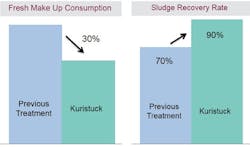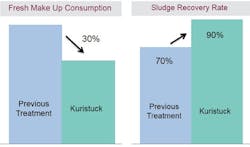Driving Down OPEX Costs
A passenger car producer had problems with foam formation due to non-ionic surfactant content of the paint. The customer uses water borne paint in a body paint line with a production of 22,500 units per month. The overspray amount is 22,500 kg/month.
The objectives included:
- Preventing foam that was caused from non-ionic surfactant in paint (which is not possible with general coagulants)
- Keeping the water neutral or slightly alkali without using hazardous chemicals for pH-adjustment
- Less blow-down from water pit
- Increasing sludge recovery
- Reducing total cost of operation.
Kurita, a worldwide experienced specialist for industrial water and process treatment, applied the patent pending Kuristuck B-800 technology. It keeps durability of foam prevention without any pH adjustment and ensures non-sticky sludge that is not adhering to the system. The result was a continuous prevention of foam formation and thus a lowered consumption of antifoams and smooth system operation as well. The water discharge from the water pit (need of fresh make up -30 percent) has been reduced thanks to removing surfactant content by chemical treatment. The sludge moisture has been reduced by 15 percent and sludge recovery rate increased by 20 percent, thus saved 31 percent of sludge disposal costs. The frequency of cleaning has been also decreased and as a result the total cost of ownership have been reduced by $100,000 per year.

